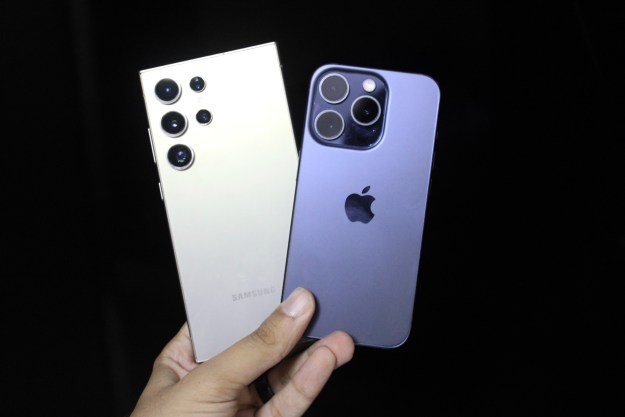Suddenly feeling like your Galaxy S21 Ultra is a bit old? Samsung has replaced it in the range with the Galaxy S22 Ultra, and as with everything shiny and new, it’s very tempting to go out and upgrade to this latest model. Before you rush to do so, though, it’s important to get an idea of what you’ll gain. While Samsung will tell you there are plenty of reasons to upgrade, what differences will you see in the real world?
I’ve used them both to see if there’s a strong reason to say goodbye to the Galaxy S21 Ultra.
Look and feel
The S22 Ultra is a little wider than the S21 Ultra, but as they are otherwise similarly sized and almost equally as heavy — 8.9mm thick and 228 grams — you may not really notice much of a change. The S22 Ultra is shaped more like the Galaxy Note 20 Ultra, with sharper, curvier sides and flat end caps. This, along with the few millimeters of extra width, does make it feel like even more of a handful than the S21 Ultra.

The S22 Ultra is just as slippery as the S21 Ultra and is liable to slide about on a lot of different surfaces, so putting it in a case is advisable. I’m using the Phantom Black model, and the finish is very similar to the S21 Ultra’s Phantom Black, and that means it may well pick up scuffs and marks if you’re not careful.
Regarding the design, Samsung has done away with the integrated camera module from the S21 Ultra and replaced it with separate camera housings on the rear panel. It’s a very different look from the S21 Ultra (and the rest of the S22 range), and while it’s pretty, it doesn’t instill the phone with much identity. What it is, though, is classy, almost regardless of the color you choose.
Taking photos
There’s a very good chance you purchased the Galaxy S21 Ultra because of the camera, so is the Galaxy S22 Ultra’s camera even better? On paper, it’s very similar, but Samsung says the sensors are different, and that it has worked on the software and processor to improve results.
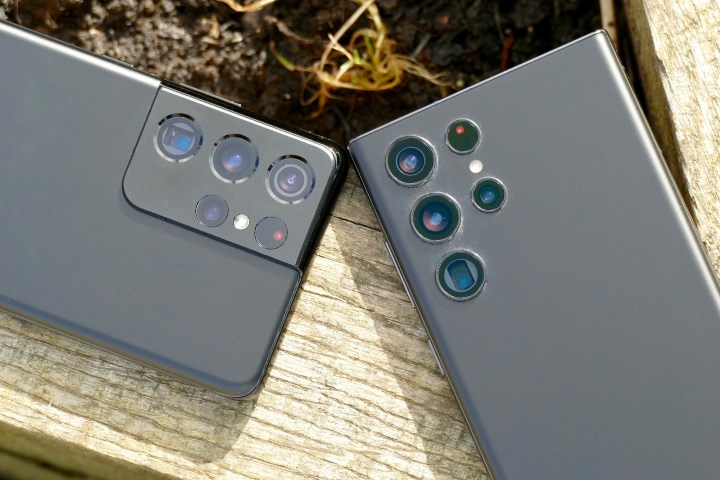
I’ve spent a few days taking photos with both, and the results are very interesting.
Night mode
Samsung says the S22 Ultra’s camera is a lowlight photography winner, and it’s absolutely correct. The balanced colors are beautiful, and it edges toward an attractive warmer tone compared to the S21 Ultra’s night mode, giving nighttime images a lovely emotional feel.

The photo here is a great example of the detail the S22 Ultra’s camera shows at night. See the white brickwork and the sharp text on the license plate of the car, plus excellent exposure to show what’s happening inside the pub through the windows for evidence.

When you look at the Galaxy S21 Ultra’s photo and compare it directly to its successor’s, you can see the additional and sharper detail, the more natural and warmer tones, and less haziness in the S22’s photo. However, looked at in solitude, you’re unlikely to be disappointed with the S21 Ultra’s photo, but when you spend time examining the S22 Ultra’s night performance, it’s clear a lot of work has been put into improving it. Whether it’s a reason to upgrade will come down to how often you shoot photos in lowlight.
Winner: Samsung Galaxy S22 Ultra
3x zoom
The 3x optical zoom has been given a small makeover, resulting in a slightly sharper image with less edge enhancement visible on the Galaxy S22 Ultra. You will have to directly compare a photo taken with it to one taken on the S21 Ultra to see the differences, though, as they are quite subtle. In this example, the iron crosses are ever so slightly sharper in the S22 Ultra’s photo, while there is also more detail on the roof itself.

It’s the same when you zoom in to the photo, with the wire netting around the spire being clearer and less fuzzy in the S22 Ultra’s photo. It’s most noticeable in the tiles below this section, where the detail is smoother and more natural in the S22 Ultra’s photo, compared to the over-enhancement in the S21 Ultra’s picture.

Overall, the Galaxy S22 Ultra’s 3x optical zoom produces less noise and either requires less digital enhancement, or it’s more intelligently used, than on the S21 Ultra. There’s definite improvement, but you will have to look closely.
Winner: Samsung Galaxy S22 Ultra
10x zoom
The improvements seen in 3x optical zoom mode are echoed in the 10x optical zoom. Already impressive on the S21 Ultra, the S22 Ultra’s 10x optical zoom is really excellent. Throughout the photo, you get more detail, better clarity, and less noise and artificial enhancement.

What was already a very good feature has become even better on the S22 Ultra compared to the S21 Ultra. Take a look at the background in this photo, which is not only more sharply focused, but also far more colorful.

I took a variety of photos at 10x optical zoom while at the beach, and the clarity is very impressive. I used it to take pictures of the waves crashing against the shore, where it wasn’t possible to get physically close, and the shots were colorful, sharp, and wonderfully detailed. The increase in quality makes the camera even more usable, and I do think you’ll see the difference even if you don’t compare the photos directly with those taken with the S21 Ultra. It’s that good.
Winner: Samsung Galaxy S22 Ultra
30x zoom
You may actually want to use the 30x zoom mode on the S22 Ultra, something that never happened with the S21 Ultra’s 30x zoom. Samsung has really improved performance with its hybrid telephoto system at this range. The S22 Ultra’s photo of the sign is sharp and well-balanced, with realistic detail and color, as well as limited evidence of blur or edge enhancement.
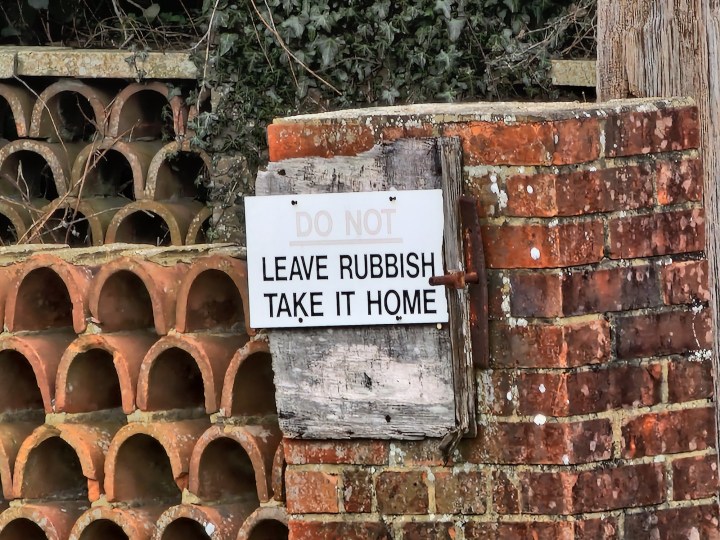
It’s not a fantastic photo, but it’s usable compared to the S21 Ultra’s 30x zoom picture. The digital enhancement is obvious in the S21 Ultra’s photo, where the camera’s software had to fill in a lot of blanks, resulting in an unnatural look, a poor level of detail, and a lack of realism.

At a glance, you could mistake the S22 Ultra’s 30x zoom photo for an optical zoom, but the S21 Ultra’s photo is very clearly a digital zoom photo.
Winner: Samsung Galaxy S22 Ultra
100x zoom
The Space Zoom mode is still not something you’d use often (ever?) on the S22 Ultra. As a technical exercise, it’s interesting, and it has got better in some ways, but it’s still an odd gimmick you’ll try once and then forget. Both photos here show an approximation of a seagull, with the S22 Ultra’s photo showing more realistic colors and a little more detail.
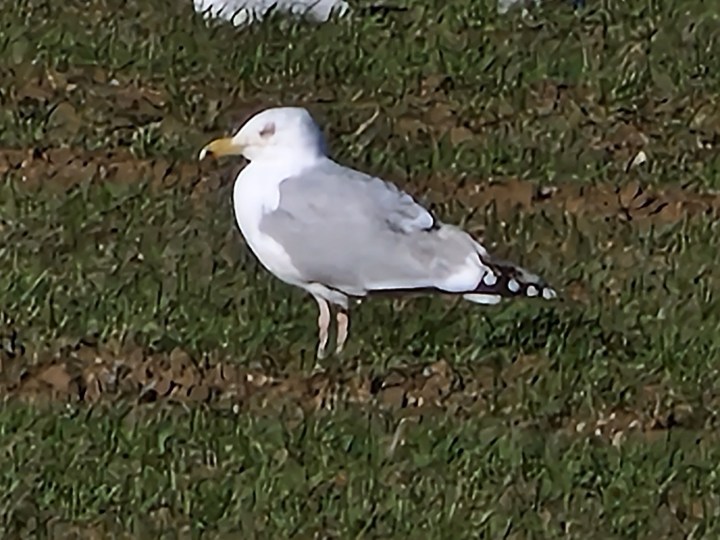
Interestingly, the S21 Ultra’s stabilization at this zoom level was more precise than the S22 Ultra’s. Both steady the shot for you, but the S21 Ultra was better at identifying what you wanted to take a photo of, and made more of an effort to keep it in the center of the frame. Because of the way the stabilization works, adjustments after it has steadied itself throw the camera off, meaning it took longer to get the photo on the S22 Ultra.

I’m using the phone ahead of release, so this may be fixed in a software update, but is hardly a big problem because who would want to take, keep, and share a photo that looks like this?
Winner: Samsung Galaxy S22 Ultra
Wide-angle
This first wide-angle photo on the hillside with the bench was taken in difficult conditions, with the morning sun to the left of the photo, and hazy conditions looking over the hillside. The second photo was taken in almost perfect conditions, so both have been used as examples here.
- 1. Galaxy S22 Ultra
- 2. Galaxy S22 Ultra
The main difference between the photos is the color of the ground, with the S22 Ultra displaying a warmer tone, which then transitions into the foliage. The treatment of the sky is very similar in both photos.
- 1. Galaxy S21 Ultra
- 2. Galaxy S21 Ultra
This is where the S22 Ultra will split opinion. I don’t think either photo is better than the other, just different, and not really in a way that makes one more visually appealing than the other. I do prefer the S22 Ultra’s photo for its tone, but would say the S21 Ultra’s photo was more representative of the conditions in real life.
Winner: Draw
Main camera
If the wide-angle camera’s performance was a particularly tough game of “spot the difference,” the main camera is even more of a challenge.

There really isn’t much to differentiate them, with very similar levels of saturation and dynamic range, and an almost identical level of detail.

Even after comparing about a dozen images from both cameras, I’m struggling to come up with a meaningful advantage to shooting with the S22 Ultra’s main camera. The S22 Ultra does have a warmer tone, which is noticeable in the stony beach here, but again, it’s not better or worse, just different.
Winner: Draw
Selfie camera and portrait mode
Shot using the portrait mode with the selfie camera on both phones, there’s a difference in skin tone between the two, but very little change in edge recognition. You can see neither phone understood the lens in my glasses should be blurred, but did nearly separate the bunting in the background from my cap, and also handled the brim in the same way.
- 1. Galaxy S22 Ultra
- 2. Galaxy S22 Ultra
Skin tone is slightly warmer from the S22 Ultra, a theme that can be seen across all the cameras, but I’d say detail was captured more effectively by the S21 Ultra. Or at least, I prefer the detail and the skin tone in the S21 Ultra’s photo, along with the deeper colors of my cap and the darker black of my top.
- 1. Galaxy S21 Ultra
- 2. Galaxy S21 Ultra
Using portrait mode with the rear camera actually provided similar results. The black of the car’s bodywork is more pronounced and darker in the S21 Ultra’s photo, while edge recognition is almost identical. Both managed to blur the wing mirror, for example, despite it being partially obscured. Zoom in more closely, and the S22 Ultra’s photo is more sharply detailed, in particular on the XJ8 badge.
Winner: Draw
Does it have a better camera?
Yes, as the Galaxy S22 Ultra’s multiple category wins above show, the camera is an improvement over the Galaxy S21 Ultra’s, but it’s very close. Most tellingly, the main and wide-angles camera take very similar photos, and it’s questionable whether one is better than the other. If you’re looking at the
Writing with the S Pen
The camera is undoubtedly the big feature on the S Series smartphone range, but for the S22 Ultra, Samsung has integrated an S Pen stylus, making it a cross between the Galaxy S21 Ultra and Galaxy Note 20 Ultra in terms of functionality and appeal. What’s the S Pen like compared to the one you could use with the S21 Ultra?

The S21 Ultra supported the S Pen stylus, but not the Bluetooth version, and to store it required a special case. The S Pen itself is twice as thick, and longer than the version that comes inside the Galaxy S22 Ultra. The size of the S Pen makes it easier and more comfortable to grip compared to the S22 Ultra’s skinny S Pen, and I find writing on the S21 Ultra’s screen simple and natural, plus I am able to do so neatly.
Samsung has lowered the latency from 9 milliseconds to just 2.8 milliseconds on the S22 Ultra, and along with changes to the screen, this means the response from its S Pen feels instantaneous. This higher precision and even more natural feel will be helpful for artists, and even when I just write notes on the screen, the almost complete lack of lag is noticeable. That’s before you look at the many Bluetooth features that come with the S22 Ultra’s S Pen, including the remote camera shutter feature.
The built-in phone storage and additional usefulness of the S22 Ultra’s S Pen, along with the reduced latency, ensures it’s a serious upgrade over the S21 Ultra’s external S Pen accessory. But if the S Pen never appealed to you, you’re not an artist, or you never take physical notes, then its presence inside the S22 Ultra is unlikely to appeal much.
Worth upgrading?
The Galaxy S22 Ultra’s telephoto cameras offer distinct improvements over the ones fitted to the Galaxy S21 Ultra, but the differences between the main and wide-angle cameras are far less obvious. Unless you really want to try the camera’s new pro-level video features, or often use the telephoto cameras, it’s hard to recommend an upgrade here.
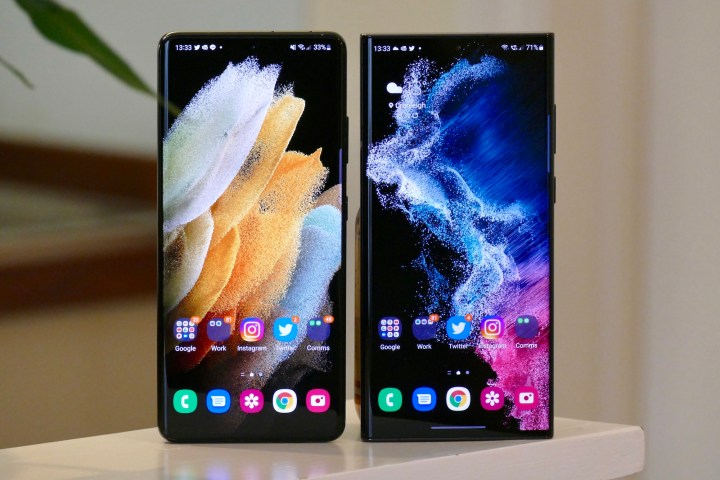
The S22 Ultra’s built-in S Pen stylus is far more convenient than the optional accessory version on the S21 Ultra, but if you never purchased one for that phone, it may not be something you care about at all. I have not noticed any major performance improvements using the S22 Ultra compared to the S21 Ultra, the screens on both look amazing, and both have almost identical software packages installed, plus support for the next few years.
I’ve enjoyed using the Galaxy S21 Ultra a lot over the last year, and it still felt incredibly fresh for the weeks I used it as my main phone just prior to the S22 Ultra’s launch. Swapping to the S22 Ultra hasn’t yielded a great change, and it operates in a very similar fashion once you get used to the even bigger phone body.
Upgrading to the Galaxy S22 Ultra will get you the very best Samsung has to offer in 2022, but the Galaxy S21 Ultra’s continued brilliance shows it was never going to be an easy task for Samsung to greatly improve on it after just 12 months.
Editors' Recommendations
- This is one of the toughest smartphone camera comparisons I’ve ever done
- Having Galaxy S24 Ultra camera issues? A fix may be coming soon
- 5 things that made me fall in love with the Galaxy S24 Ultra
- The Samsung Galaxy S24 just got destroyed in this camera test
- 5 phones you should buy instead of the Samsung Galaxy S24 Ultra









